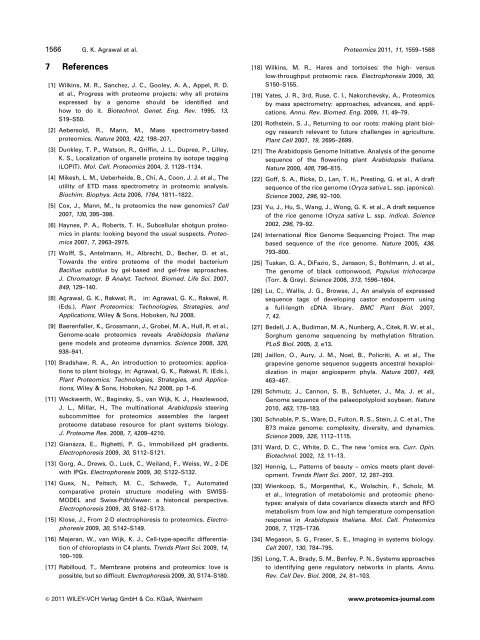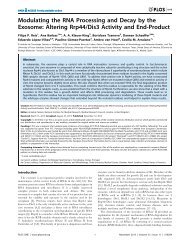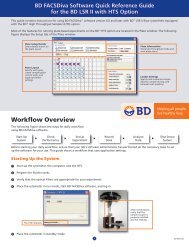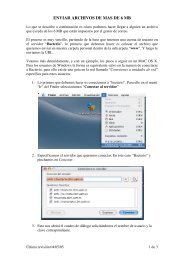Cover Picture: Proteomics 9'11
Cover Picture: Proteomics 9'11
Cover Picture: Proteomics 9'11
- No tags were found...
Create successful ePaper yourself
Turn your PDF publications into a flip-book with our unique Google optimized e-Paper software.
1566 G. K. Agrawal et al. <strong>Proteomics</strong> 2011, 11, 1559–15687 References[1] Wilkins, M. R., Sanchez, J. C., Gooley, A. A., Appel, R. D.et al., Progress with proteome projects: why all proteinsexpressed by a genome should be identified andhow to do it. Biotechnol. Genet. Eng. Rev. 1995, 13,S19–S50.[2] Aebersold, R., Mann, M., Mass spectrometry-basedproteomics. Nature 2003, 422, 198–207.[3] Dunkley, T. P., Watson, R., Griffin, J. L., Dupree, P., Lilley,K. S., Localization of organelle proteins by isotope tagging(LOPIT). Mol. Cell. <strong>Proteomics</strong> 2004, 3, 1128–1134.[4] Mikesh, L. M., Ueberheide, B., Chi, A., Coon, J. J. et al., Theutility of ETD mass spectrometry in proteomic analysis.Biochim. Biophys. Acta 2006, 1764, 1811–1822.[5] Cox, J., Mann, M., Is proteomics the new genomics? Cell2007, 130, 395–398.[6] Haynes, P. A., Roberts, T. H., Subcellular shotgun proteomicsin plants: looking beyond the usual suspects. <strong>Proteomics</strong>2007, 7, 2963–2975.[7] Wolff, S., Antelmann, H., Albrecht, D., Becher, D. et al.,Towards the entire proteome of the model bacteriumBacillus subtilus by gel-based and gel-free approaches.J. Chromatogr. B Analyt. Technol. Biomed. Life Sci. 2007,849, 129–140.[8] Agrawal, G. K., Rakwal, R., in: Agrawal, G. K., Rakwal, R.(Eds.), Plant <strong>Proteomics</strong>: Technologies, Strategies, andApplications, Wiley & Sons, Hoboken, NJ 2008.[9] Baerenfaller, K., Grossmann, J., Grobei, M. A., Hull, R. et al.,Genome-scale proteomics reveals Arabidopsis thalianagene models and proteome dynamics. Science 2008, 320,938–941.[10] Bradshaw, R. A., An introduction to proteomics: applicationsto plant biology, in: Agrawal, G. K., Rakwal, R. (Eds.),Plant <strong>Proteomics</strong>: Technologies, Strategies, and Applications,Wiley & Sons, Hoboken, NJ 2008, pp 1–6.[11] Weckwerth, W., Baginsky, S., van Wijk, K. J., Heazlewood,J. L., Millar, H., The multinational Arabidopsis steeringsubcommittee for proteomics assembles the largestproteome database resource for plant systems biology.J. Proteome Res. 2008, 7, 4209–4210.[12] Gianazza, E., Righetti, P. G., Immobilized pH gradients.Electrophoresis 2009, 30, S112–S121.[13] Gorg, A., Drews, O., Luck, C., Weiland, F., Weiss, W., 2-DEwith IPGs. Electrophoresis 2009, 30, S122–S132.[14] Guex, N., Peitsch, M. C., Schwede, T., Automatedcomparative protein structure modeling with SWISS-MODEL and Swiss-PdbViewer: a historical perspective.Electrophoresis 2009, 30, S162–S173.[15] Klose, J., From 2-D electrophoresis to proteomics. Electrophoresis2009, 30, S142–S149.[16] Majeran, W., van Wijk, K. J., Cell-type-specific differentiationof chloroplasts in C4 plants. Trends Plant Sci. 2009, 14,100–109.[17] Rabilloud, T., Membrane proteins and proteomics: love ispossible, but so difficult. Electrophoresis 2009, 30, S174–S180.[18] Wilkins, M. R., Hares and tortoises: the high- versuslow-throughput proteomic race. Electrophoresis 2009, 30,S150–S155.[19] Yates, J. R., 3rd, Ruse, C. I., Nakorchevsky, A., <strong>Proteomics</strong>by mass spectrometry: approaches, advances, and applications.Annu. Rev. Biomed. Eng. 2009, 11, 49–79.[20] Rothstein, S. J., Returning to our roots: making plant biologyresearch relevant to future challenges in agriculture.Plant Cell 2007, 19, 2695–2699.[21] The Arabidopsis Genome Initiative. Analysis of the genomesequence of the flowering plant Arabidopsis thaliana.Nature 2000, 408, 796–815.[22] Goff, S. A., Ricke, D., Lan, T. H., Presting, G. et al., A draftsequence of the rice genome (Oryza sativa L. ssp. japonica).Science 2002, 296, 92–100.[23] Yu, J., Hu, S., Wang, J., Wong, G. K. et al., A draft sequenceof the rice genome (Oryza sativa L. ssp. indica). Science2002, 296, 79–92.[24] International Rice Genome Sequencing Project. The mapbased sequence of the rice genome. Nature 2005, 436,793–800.[25] Tuskan, G. A., DiFazio, S., Jansson, S., Bohlmann, J. et al.,The genome of black cottonwood, Populus trichocarpa(Torr. & Gray). Science 2006, 313, 1596–1604.[26] Lu, C., Wallis, J. G., Browse, J., An analysis of expressedsequence tags of developing castor endosperm usinga full-length cDNA library. BMC Plant Biol. 2007,7, 42.[27] Bedell, J. A., Budiman, M. A., Nunberg, A., Citek, R. W. et al.,Sorghum genome sequencing by methylation filtration.PLoS Biol. 2005, 3, e13.[28] Jaillon, O., Aury, J. M., Noel, B., Policriti, A. et al., Thegrapevine genome sequence suggests ancestral hexaploidizationin major angiosperm phyla. Nature 2007, 449,463–467.[29] Schmutz, J., Cannon, S. B., Schlueter, J., Ma, J. et al.,Genome sequence of the palaeopolyploid soybean. Nature2010, 463, 178–183.[30] Schnable, P. S., Ware, D., Fulton, R. S., Stein, J. C. et al., TheB73 maize genome: complexity, diversity, and dynamics.Science 2009, 326, 1112–1115.[31] Ward, D. C., White, D. C., The new ’omics era. Curr. Opin.Biotechnol. 2002, 13, 11–13.[32] Hennig, L., Patterns of beauty – omics meets plant development.Trends Plant Sci. 2007, 12, 287–293.[33] Wienkoop, S., Morgenthal, K., Wolschin, F., Scholz, M.et al., Integration of metabolomic and proteomic phenotypes:analysis of data covariance dissects starch and RFOmetabolism from low and high temperature compensationresponse in Arabidopsis thaliana. Mol. Cell. <strong>Proteomics</strong>2008, 7, 1725–1736.[34] Megason, S. G., Fraser, S. E., Imaging in systems biology.Cell 2007, 130, 784–795.[35] Long, T. A., Brady, S. M., Benfey, P. N., Systems approachesto identifying gene regulatory networks in plants. Annu.Rev. Cell Dev. Biol. 2008, 24, 81–103.& 2011 WILEY-VCH Verlag GmbH & Co. KGaA, Weinheimwww.proteomics-journal.com

















